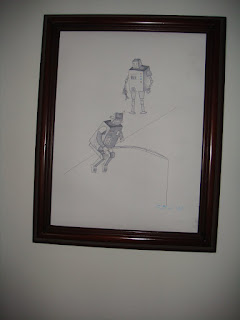.JPG)
It's time to sum up another work-related adventure! This time I arrive in a bizarre region occupied by two polar-opposite types of people. Half the population of Peoria, Illinois is made up of the corn growing farmers. These folks are all over 6 feet tall, listen to Christian talk radio, eat Velveeta cheese, creamy peanut butter, and drink sunny delight. White folks don’t get any more square than this. Comprising the other half of the population are black people who are just as far from the center of the spectrum. They wear there pants below their knees, listen to loud rhymes about sexual anatomy and activity, drink tall cans of cheap beer and eat fried chicken. After staying here a week, I’ve found only two people who are exceptions to these categories.
The man in the room next to mine is in his upper 60’s, and in poor health. His most defining characteristic is the stoma in his neck from a tracheotomy. He has to cover it with his finger to
.JPG)
speak, but his raspy, quiet voice is barely understandable. Regardless of his condition, he has a lot to say. In fact, I haven’t been able to get anything out of my car without engaging in a discussion that lasts at least 20 minutes. I don’t understand much of what he is saying, so I just guess and reply with my own comments. In the end, conversational coherence probably isn’t as important to him as the conversation itself. He doesn’t seem to have much going on in his life and likes my company.
The other character I interact with is the Indian hotel owner. He only takes payments in cash, and conducts business through a thick glass window, with a hole at the bottom. When I approach, he removes the small piece of wood which keeps the refrigerated air inside the lobby, and the smell of incense billows out at me. I glance up at the screen saver scrolling Hindi gods across his computer and pass my money through the window. Our encounters are brief, but he’s friendly and eager to make sure I’m enjoying my room.
.JPG)
The work I’m doing involves fixing the instruments on a tower which is on a wind farm. This wind farm has hundreds of turbines spread throughout thousands of acres of corn fields. Every day I drive 40 miles through corn fields to get to the job site. Once I reach wind turbine number one, I walk through about 300 feet of corn stalks to get to the tower. The corn is taller than me, so I can’t really see out. I have to orient myself toward the tower and march through the thick leaves for several minutes, hoping I can maintain my bearing well enough to reach the tower.
.JPG)
And now the fun part of the job begins. This particular tower is two hundred and sixty five feet tall. From the top, I can see clear to Nebraska (It’s corn all the way there). After the day is over, I sit and watch the lightning bugs flash their yellow lights at the setting sun. I drink fresh apple juice from a nearby orchard and look for foxes and raccoons.
I’ve been busy in the field with work until today. This evening I walked down to the river and was lucky to come across a free jazz concert. There were only about 20 people in the audience, so I felt intimately connected to the musicians and their music. I was treated with nearly an hour of live music as I watched the full moon rise behind a gigantic cage-bridge. An old fashioned paddle boat made its way by too.
I conclude with a commentary about bridges. After the concert, I found a quiet place along the river and stared into the water for a while. In the foreground was the large steel bridge, adorned with beautiful architectural features; strong iron beams united by rows upon rows of perfectly spaced round rivets, artistic blue lights highlighting the angles, and massive pylons stretching down into the water. This bridge announces boldly its presence, and its might.
.JPG)
In the background was a newer, sleek concrete bridge. It was drafted on computers by engineers from top schools, and run through simulations of floods and earthquakes. It costs less to build and is probably more reliable. It’s utterly boring. I’ve noticed that for the past decade, the iron cage-bridges across the country are systematically being replaced by these passive concrete structures. This is a tragedy. Not only are we losing the architectural beauty of the old style bridges, but we’re also losing connection with our environment. The Iron bridges have such presence that passing over one is a distinct experience. The newer concrete bridges, however, are crossed without even noticing. This is where the crime occurs. Crossing a river is a significant event, which we’ve all become complacent to. We can cross rivers with such ease that we do it without even realizing it’s happening. These old iron cage-bridges stand as a reminder that
.JPG)
without bridges we’d be stranded. They allow the river to be recognized as a significant feature of a journey. I suggest having reverence for every river crossing, and to appreciate the ease at which it can now be done.
corn on the cob.

































.JPG)
.JPG)
.JPG)
.JPG)
.JPG)
.JPG)
.JPG)
.JPG)
.JPG)
.JPG)
.JPG)
.JPG)
.JPG)
.JPG)
.JPG)
